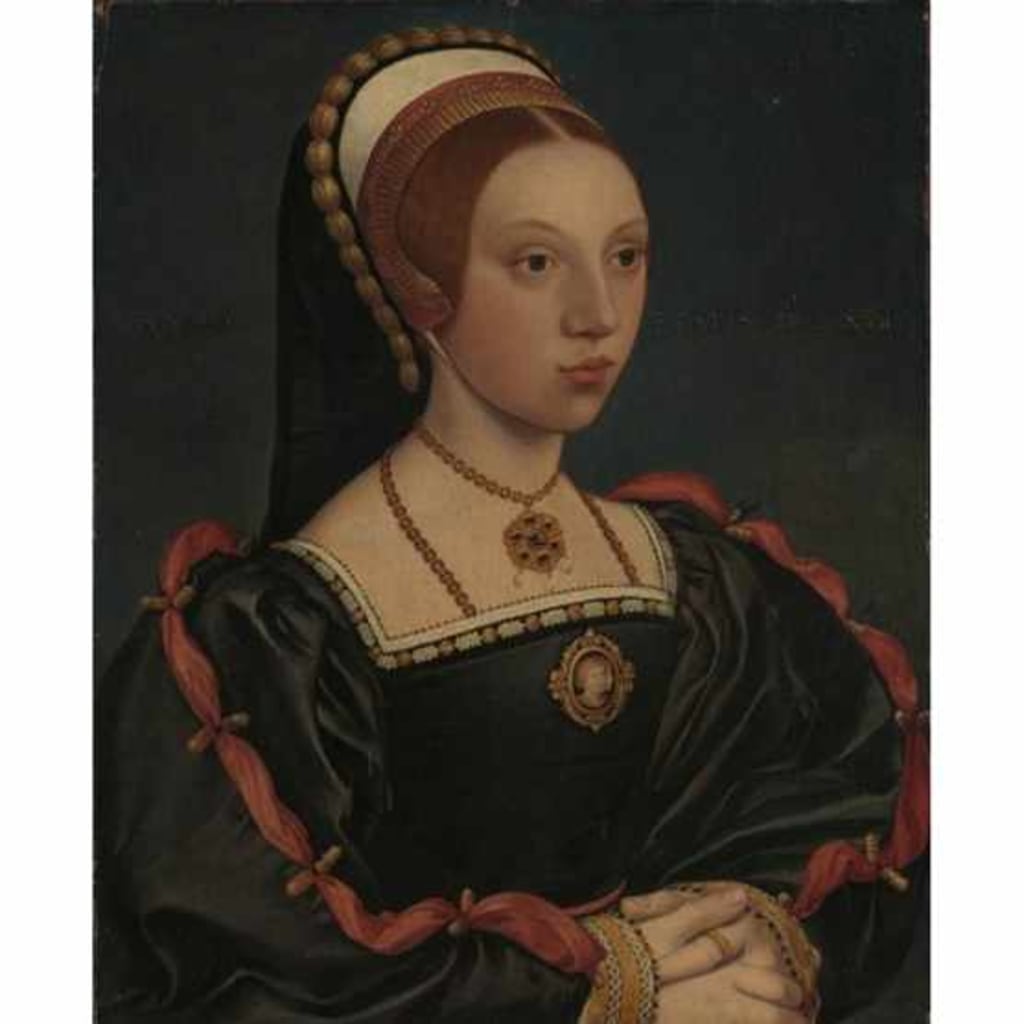Catherine Howard: Vixen or Victim?
What do you really know about the 5th wife of Henry the 8th?

Catherine Howard was Henry the 8th fifth wife. She was born sometime during 1523. When the two wed Henry was 49 while his new bride was 17. Their marriage lasted 1 year, 3 months, and 26 days. She was charged with committing adultery(Treason) with her distant cousin Thomas Culpeper, who was a friend of Henry. On February 13, 1542 Catherine was beheaded by axe and buried next to Anne Bolyen who was her first cousin.
In most portrayals of Catherine she is pegged as “The young, pretty and dumb” type and the her promiscuous ways are the reason she and her lovers were killed. However many of those portrayals never talk about her childhood.
Early Life:
After the death of her mother in 1528, Catherine was sent along with some of her other siblings to her father’s stepmother: The Dowager Duchess of Norfolk, Agnes. The Dowager Duchess presided over large households at Chesworth House in Horsham in Sussex, and at Norfolk House in Lambeth where dozens of attendants, along with her many wards were usually the children of noble parents but of poor means. Agnes was almost always at court and didn’t have much involvement with the girls, and thus discipline was something the wards including Catherine rarely saw.
Catherine became influenced by the other girls, who let men into the sleeping quarters. For this the girls were given food, wine, and gifts for their “services”. It should be noted that Catherine wasn’t as nearly educated as Henry’s first 2 wives. The fact that she could read and write was seen as shocking at the time. Nor did she have religious views that many had at the time. But she did have fondness of dancing, music and loved animals (especially dogs).
Sometime during 1536, Catherine began music lessons with two teachers. One of which was Henry Mannox. Henry’s exact age is unknown but it’s believed that he was around 36 at the time. Catherine was 13 when their “relationship” began. Many modern historians believe that Mannox was grooming and extremely abusive towards Catherine(between 1536-38) and often pressured her to give her virginity to him. She and Mannox both confessed that they had sexual contact but never actual intercourse.
During the questioning that led to her execution, she was quoted "At the flattering and fair persuasions of Mannox, being but a young girl, I suffered him at sundry times to handle and touch the secret parts of my body, which neither became me with honesty to permit nor him to require."
In 1538, Catherine lost contact with Mannox (she spent more time in a different house). Not long after a man by the name of Francis Dereham, he was the secretary of the Dowager Duchess. He and Catherine were rumored to be lovers, often addressing each other as Husband and Wife. He also gave her “wifely duties” (keeping his money while he was away). Many people, including myself believe that Dereham was the closest thing that Catherine had to love. If Catherine had it her way that she and Dereham would have officially married.
However this was not met to be.
When Henry Mannox learned of the relationship, he was extremely jealous of the love Catherine had for Francis. So Mannox told the Dowager Duchess to go to the bed quarters a half an hour after bedtime. The relationship ended in 1539, when the Duchess sent Mannox away to Ireland. However He and Catherine planned to marry once he returned and even had a contract of marriage, and had sexual intercourse. Note that if it was proven that they exchanged vows that in the eyes the church they would be legally married.
Life as Lady-in-waiting:
Catherine's uncle, the Duke of Norfolk, found her a place at Court in the household of the King's fourth wife, Anne of Cleves. As a young and attractive lady-in-waiting, Catherine quickly caught Henry's eye. The King had displayed little sexual desire for Anne from the moment he laid eyes on her. The Duke had hoped to gain power and wealth for his family through Catherine via the king’s bed, just as his cousins did with Anne Boleyn. The Duke saw Catherine as nothing more than a pretty pawn.
Henry loved Catherine.
And by “Catherine” he loved her for her youth, beauty, and her lack of views (Unlike some of his previous wives). Not long after arriving at court, the King began to give her gifts of land and expensive clothing and called her “The very jewel of Womanhood”
Life as Queen:
Once Henry divorced Anne of Cleves, he and Catherine were engaged; And marriage the same day Thomas Cromwell(the man who arranged Henry’s fourth marriage) was executed. Henry gave Catherine anything she wanted thanks to her motto: Non autre volonté que la sienne or "No other wish but his"
Catherine was like the ‘Marie Antoinette’ of her time, always wearing the latest french fashion and decked out in various jewels. Henry had hoped that Catherine would give him plenty of children(mainly sons).
However there were many downsides to being the wife of King Henry the 8th. The king was old, and had gained a lot of weight due to an accident that occurred in 1527. His leg never truly healed and oozed pus that smelled. Not to mention this accident also gave him a severe concussion which changed his personality. He was quick to anger.
Tomas Culpepper:
Tomas Culpepper was born around 1514,in 1538, Culpepper quickly became a favorite of Henry’s and was often bribed by others to use his position for others. Thomas is often described as a handsome youth, both during his time and portrayals in the media.
However the many versions of Culpepper fail to mention is that he was accused of raping a park keepers wife and murder of a villager. (But please note that Thomas had an older brother who was also named Thomas). But nevertheless the crimes were pardoned by the king himself, and Thomas was made a Gentleman to the King’s privy chamber. A great honor and was given several pieces of land.In 1540 Catherine caught the eye of Thomas.
The results of their affair were not well for anyone involved.
Downfall and Death:
It had been rumored that the two began meeting in secret and being arranged by a lady-in-waiting (Lady Rochford) who was also the widow of George Boleyn, brother to the late queen Anne. Culpepper would send love letters to the queen calling her “my little, sweet fool”
But Catherine didn’t just have rumors at court to worry about. Some of the wards (still in the homes of the Dowager Duchess) were blackmailing Catherine, threatening to inform the King of the affairs that Cathrine engaged in while under the Duchess’ roof (even though only one was consensual). Some were even appointed to her household in order to keep them quiet, one of those people being Francis Dereham.
Some historians believe that Culpepper got wind of the rumors and used his position and friendship with the King, to blackmail Catherine into sex, and his slience in exchange.
Enter Thomas Cranmer, the Archbishop of Canterbury who desperately wanted to get rid of his Roman Cathlolic rivals: The Norfolks. Lady Rochford was questioned and remembering the fate of her Husband and Sister-in-law, Anne. She quickly confessed that she often helped Culpepper escape the Queen’s bed chambers. Shortly after a love letter with the Queen’s handwriting was discovered in Culpeppers quarters.
When Henry learned of the investigation against Catherine, at first he refused to believe that his “Jewel of womanhood” would do such a thing, but Cranmer kept bringing in more evidence. Henry called for her arrest. November, 7th 1541, when the guards came for her, she tried to run and find the King while screaming for mercy. Cranmer also had any item that could be used for suicide fearing the young Queen would end her life.
On November 23, 1541 Catherine was stripped of her title of Queen and imprisoned. Both Culpepper and Dereham were charged with high Treason and executed on December 10, 1541. Culpepper was given a more merciful death via beheading. Dereham was hanged, drawn, and quartered. Many of Catherine’s family were also arrested, However her Uncle who was the one who pushed her into Henry’s bed was nowhere to be seen. Basically abandoning not just Catherine but his other family members as well.
She remained in prison for four months. She was never given a trial. On February 7, 1542 The Royal Assent by Commission Act of 1541 was passed. It made it treason, and punishable by death, for a queen consort to fail to disclose her sexual history to the king within twenty days of their marriage, or to incite someone to commit adultery with her.
This sealed Catherine fate. The night before Catherine's execution, she spent practicing how to lay her head on the chopping block. She most likely did this because her death was going to by the swing of an axe. Many executions were often botched because of the duller blade or because the axeman couldn’t aim. So it was most likely she feared a slow and painful death.
On February 13, 1542 was brought to a crowd. She was described as being pale and terrified and needed help climbing the scaffold. She tells the crowd that her punishment is Just and worthy and asked for mercy for her family. According to legend her last words were “ I die a Queen, but I would rather have died the wife of Culpeper” however no one supported it. Some believe that it was attributed to her after her death. As a way to make her seem like a harlot.
She was killed with a single blow of the axe. She was buried near her cousins, Anne and George Boleyn. She was only 19 years old.
In the media most people see Catherine Howard as a silly little girl, whose “Whoredom” caught up to her and got her and others killed. That if she kept her legs closed she would've lived a long life as a Queen.
What many fail to realize is that Catherine was a child, a child was abused from the ages of 13 to 15. Her only small glimmer of happiness (Dereham) was sent away by the actions of her abuser(Mannox). Forced by an ambitious Uncle to sexually please a man who was 33-34 years her senior and then married that man. Only to be immediately blackmailed by those she called friends and Husband (Dereham) in the past. Culpepper was possibly another blackmailer using his to get in the bed of the teenage Queen.
She beauty was used as a tool, both for sex and power. She was a pawn in someone else’s game and was rewarded with death and infamy as Henry the 8th’s whore of a queen.
But I’ll let you be the judge.






Comments
There are no comments for this story
Be the first to respond and start the conversation.